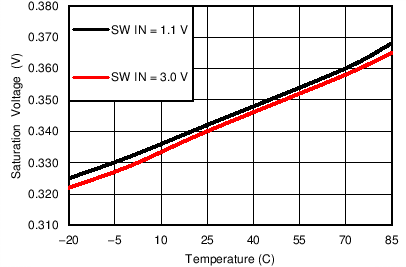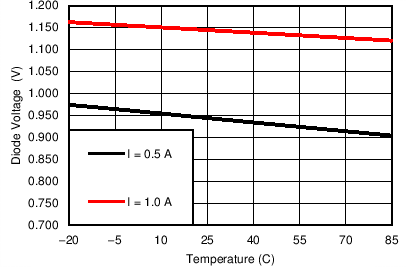SLVS029H January 1984 – November 2015 TL499A
PRODUCTION DATA.
- 1 Features
- 2 Applications
- 3 Description
- 4 Revision History
- 5 Pin Configuration and Functions
- 6 Specifications
- 7 Detailed Description
- 8 Application and Implementation
- 9 Power Supply Recommendations
- 10Layout
- 11Device and Documentation Support
- 12Mechanical, Packaging, and Orderable Information
パッケージ・オプション
デバイスごとのパッケージ図は、PDF版データシートをご参照ください。
メカニカル・データ(パッケージ|ピン)
- P|8
- PS|8
サーマルパッド・メカニカル・データ
発注情報
6 Specifications
6.1 Absolute Maximum Ratings
over operating free-air temperature range (unless otherwise noted)(1)| MIN | MAX | UNIT | |||
|---|---|---|---|---|---|
| VO | Output voltage(2) | –0.3 | 35 | V | |
| VI1 | Input voltage, series regulator | –0.3 | 35 | V | |
| VI2 | Input voltage, switching regulator | –0.3 | 10 | V | |
| Blocking-diode reverse voltage | 35 | V | |||
| Blocking-diode forward current | 1 | A | |||
| SW IN | Power switch current | 1 | A | ||
| Lead temperature 1.6 mm (1/16 inch) from case for 10 seconds | 260 | °C | |||
| TJ | Junction temperature | 150 | °C | ||
| Tstg | Storage temperature | –65 | 150 | °C | |
(1) Stresses beyond those listed under Absolute Maximum Ratings may cause permanent damage to the device. These are stress ratings only, which do not imply functional operation of the device at these or any other conditions beyond those indicated under Recommended Operating Conditions. Exposure to absolute-maximum-rated conditions for extended periods may affect device reliability.
(2) All voltage values are with respect to network ground terminal.
6.2 ESD Ratings
| VALUE | UNIT | |||
|---|---|---|---|---|
| V(ESD) | Electrostatic discharge | Human body model (HBM), per ANSI/ESDA/JEDEC JS-001(1) | ±200 | V |
| Charged-device model (CDM), per JEDEC specification JESD22-C101(2) | ±2000 | |||
(1) JEDEC document JEP155 states that 500-V HBM allows safe manufacturing with a standard ESD control process. Manufacturing with less than 500-V HBM is possible with the necessary precautions. Pins listed as ±200-V may actually have higher performance.
(2) JEDEC document JEP157 states that 250-V CDM allows safe manufacturing with a standard ESD control process.
6.3 Recommended Operating Conditions
over operating free-air temperature range (unless otherwise noted)| MIN | NOM | MAX | UNIT | ||
|---|---|---|---|---|---|
| Output voltage, VO | 2.9 | 30 | V | ||
| Input voltage, VI1 (SERIES IN1) | 4.5 | 32 | V | ||
| Input voltage, VI2 (SW REG IN2) | 1.1 | 10 | V | ||
| Output-to-input differential voltage, switching regulator, VO – VI2 (see (1)) | 1.2 | 28.9 | V | ||
| Continuous output current, IO | 100 | mA | |||
| Power switch current (at SW IN) | 500 | mA | |||
| Current-limiting resistor, RCL | 150 | 1000 | Ω | ||
| Filter capacitor | 100 | 470 | µF | ||
| Pass capacitor | 0.1 | µF | |||
| Inductor, L (dcr ≤ 0.1 Ω) | 50 | 150 | µH | ||
| Operating free-air temperature, TA | –20 | 85 | °C | ||
(1) When operating temperature range is TA≤ 70°C, minimum VO– VI2 is ≥ 1.2 V. When operating temperature range is TA ≤ 85°C, minimum VO – VI2 is ≥ 1.9 V.
6.4 Thermal Information
| THERMAL METRIC(1) | TL499A | UNIT | ||
|---|---|---|---|---|
| P (PDIP) | PS (SO) | |||
| 8 PINS | 8 PINS | |||
| RθJA | Junction-to-ambient thermal resistance(2)(3) | 49.7 | 110.7 | °C/W |
| RθJC(top) | Junction-to-case (top) thermal resistance | 38.8 | 69.0 | °C/W |
| RθJB | Junction-to-board thermal resistance | 26.9 | 55.7 | °C/W |
| ψJT | Junction-to-top characterization parameter | 16.1 | 20.1 | °C/W |
| ψJB | Junction-to-board characterization parameter | 26.7 | 54.9 | °C/W |
(1) For more information about traditional and new thermal metrics, see the Semiconductor and IC Package Thermal Metrics application report, SPRA953.
(2) Maximum power dissipation is a function of TJ(max), θJA, and TA. The maximum allowable power dissipation at any allowable ambient temperature is PD = (TJ(max) – TA) / θJA. Operating at the absolute maximum TJ of 150°C can affect reliability.
(3) The package thermal impedance is calculated in accordance with JESD 51-7.
6.5 Electrical Characteristics
over operating free-air temperature range (unless otherwise noted)| PARAMETER | TEST CONDITIONS | MIN | TYP | MAX | UNIT | |
|---|---|---|---|---|---|---|
| Voltage deviation (see (1)) | 20 | 30 | mV/V | |||
| VO – VI2 | Switching regulator minimum boost | TA = –20°C to 70°C | 1.2 | V | ||
| TA = –20°C to 85°C | 1.9 | |||||
| Dropout voltage | Series regulator | VI1 = 15 V, IO = 50 mA | 1.8 | V | ||
| Reference voltage (internal) | VI1 = 5 V, VO = 3 V, IO = 1 mA | 1.2 | 1.26 | 1.32 | V | |
| Reference-voltage change with temperature | 5 | 10 | mV/V | |||
| Output regulation (of reference voltage) | IO = 1 mA to 50 mA | 10 | 30 | mV/V | ||
| Output current (see Figure 3) |
Switching regulator | VI2 = 1.1 V, VO = 12 V, RCL = 150 Ω, TA = 25°C |
10 | mA | ||
| VI2 = 1.5 V, VO = 15 V, RCL = 150 Ω, TA = 25°C |
15 | |||||
| VI2 = 6 V, VO = 30 V, RCL = 150 Ω, TA = 25°C |
65 | |||||
| Series regulator | 100 | |||||
| Standby current | Switching regulator | VI2 = 3 V, VO = 9 V, TA = 25°C | 15 | 80 | µA | |
| Series regulator | VI1 = 15 V, VO = 9 V, RE2 = 4.7 kΩ | 0.8 | 1.2 | mA | ||
(1) Voltage deviation is the output voltage difference that occurs in a change from series regulation to switching regulation: Voltage deviation = VO (series regulation) – VO (switching regulation)
6.6 Typical Characteristics

